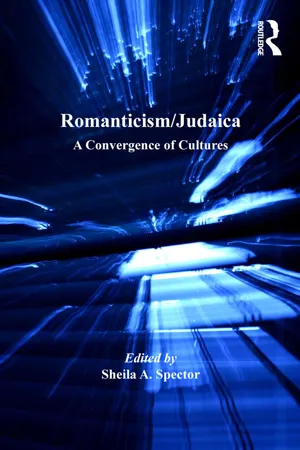
- 242 pages
- English
- ePUB (mobile friendly)
- Available on iOS & Android
About This Book
The twelve essays in Romanticism/Judaica explore the four major cultural strands that have converged from the French Revolution to the present. The first section, Nationalism and Diasporeanism, contains essays on the diasporean mentality of the Romantics, Byron's attitude towards nationalism, and Polish immigrant Hyman Hurwitz's attempt to gain acceptance among the British by having Coleridge translate his Hebrew elegy for Princess Charlotte. Essays of the second section, Religion and Anti-Semitism, deal with the complexities of Jewish/Christian relations in the Romantic Period. Specifically, they discuss philosopher Solomon Maimon's lack of response to Kant's anti-Semitism, novelist Maria Polack's use of Christian subject matter to combat anti-Semitism, and short-story writer Grace Aguilar's incorporation of the British Bible-centered Evangelical culture, along with various strands of British Romanticism. In the third section, Individualism and Assimilationism, essays consider different ways the Jews were assimilated into the dominant culture, specifically through the theater, sports and and post-Enlightenment philosophy. Finally, the volume concludes with Criticism and Reflection: a revaluation of earlier scholarship on Anglo-Jewish literature; the establishment of Harold Fisch's covenantal hermeneutics as a model for reading Keats; and an analysis of Lionel Trilling, M. H. Abrams, Harold Bloom and Geoffrey Hartman in terms of their Jewish origins, suggesting the further implications for Romanticism as a field.
Frequently asked questions
Information
1 Nationalism and Diasporeanism
1 Enactments of Exile and Diaspora in English Romantic Literature
When Wiesel went to see him, he [the Dalai Lama] asked, "Why did you want to meet me?" And the Dalai Lama said, 'I'il tell you why." He continued, "Your people suffered a lot and you went into exile 2,000 years ago, but you are still here. My people just left our homeland; we are in exile. Teach us how to survive."11 Elie Wiesel, interview on The Jewish People: A Story of Survival, PBS, 2008, http://www.pbs.org/previews/jewishpeople.
Diasporas were a common feature of the Hellenistic-Roman world. In the fourth century BCE, colonies of Egyptian. Syrian, and Phoenician merchants were frequently in the seaports of Greece and Italy. After the conquests of Alexander the Great, Greeks and Macedonians constituted an immense Diaspora throughout the Near East. Ethnic resettlement and religious diffusion went hand in hand, as settlers brought with them ancestral cults and won for their gods new worshippers among the local population. Although not unique, the Jewish Diaspora was outstanding in its ability to preserve and perpetuate its identity at considerable distance from the homeland and over large stretches of time.33 Robert M. Seltzer, "The Expanding Diaspora," in Jewish People, Jewish Thought: The Jewish Experience in History (New York: Prentice-Hall, 1980); repr., http://www.myjewisMeaniing.com/liistory_conuiiunity/Ancient/TheStoryI/Expanding_Diaspora.htm.
... David s lyre grew mightier than his throne!It told the triumphs of our King,It wafted gloiy to our God;It made our gladden'd valleys ring,The cedars bow, the mountains nod;Its sound aspired to heaven and there abode!Since then, though heard on earth no more,Devotion and her daughter LoveStill bid the bursting spirit soarTo sounds that seem as from above.In dreams that day's broad light can not remove.( Il. 10-20)77 George Gordon, Lord Byron, Hebrew Melodies (London: John Murray, 1815), 5-6. Future quotations from Hebrew Melodies will be from the 1815 edition, and will be cited parenthetically by line number.
Oh! weep for those that wept by Babel s stream.Whose shrines are desolate, whose land a dream_Weep for the harp of Judali s broken shell;Moum—where their God hath dwelt the godless dwell!And where shall Israel lave her bleeding feet?And when shall Zion's songs again seem sweet?...The wild-dove hath her nest the fox his cave.The wild-dove hath her nest the fox his cave.Mankind their country—Israel but the grave!( ll. 1-12)
And now on that mountain I stood on that day.But I mark'd not the twilight beam melting away;Oh! would that the lightning had glared in its stead,And the thunderbolt burst on the conqueror's head!But the gods of the Pagan shall never profaneThe shrine where Jehovah disdain'd not to reign;And scattered and scorn d as thy people may be,Our worship, oh Father! is only for thee.( ll. 13-20)
From the last hill that looks on thy once holy dome,I beheld thee, oh Sion! when render'd to Rome:'Twas thy last sun went down, and the flames of thy fallFlash'd back on the last glance I gave to thy wall.I look'd for thy temple, I look'd for my home,And forgot for a moment my bondage to come;I beheld but the death-fire that fed on thy fane,And the fast-fetter'd liands that made vengeance in vain.Oh many an eve, the high spot whence I gazedHad reflected the last beam of day as it blazed;While I stood on the height, and beheld the declineOf the rays from the mountain that shone on thy shrine.( 11. 1-12)
Like thee doth our nation lie conquer'd and broken.And fall'n from her head is the once royal crown;In her streets, in her halls. Desolation hath spoken.And "while it is day yet, her sun hath gone down."Like thine doth her exile, 'mid dreams of returning.Die far from the home it were life to behold;Like thine do her sons, in the day of their mourningRemember the bright tilings that bless'd them of old.99 Thomas Moore, "The Parallel," ThomasMore Poems, http://famouspoetsandpoems.com/poets/thomas_moore/poems/4825, 11. 5-12.
Table of contents
- Cover
- Half Title Page
- Title Page
- Copyright Page
- Table of Contents
- List of Figures
- List of Contributors
- Preface
- Introduction: The Convergence of Romanticism and Judaica
- Part 1 Nationalism and Diasporeanism
- Part 2 Religion and Anti-Semitism
- Part 3 Individualism and Assimilationism
- Part 4 Criticism and Reflection
- Works Cited
- Index